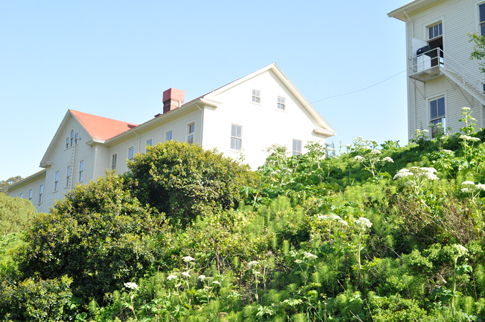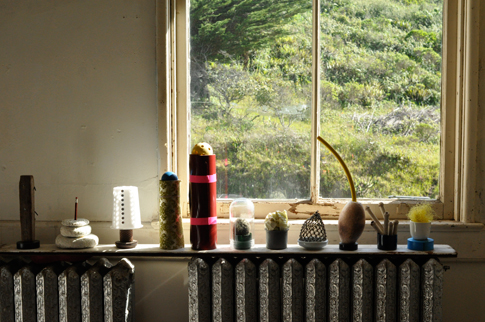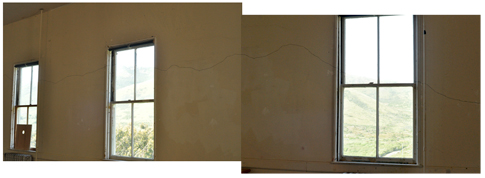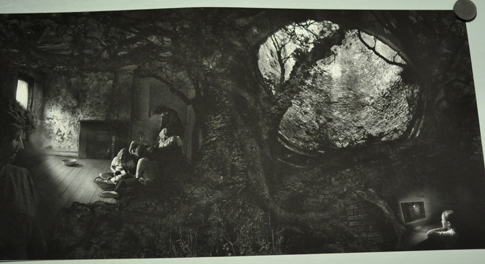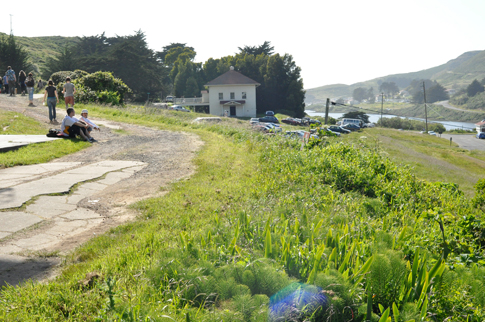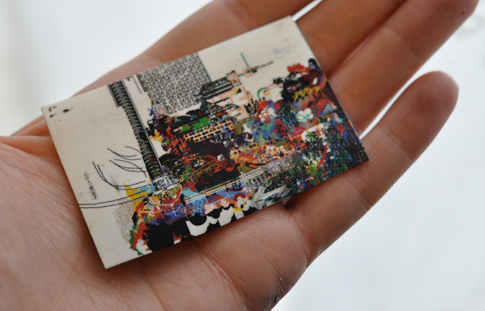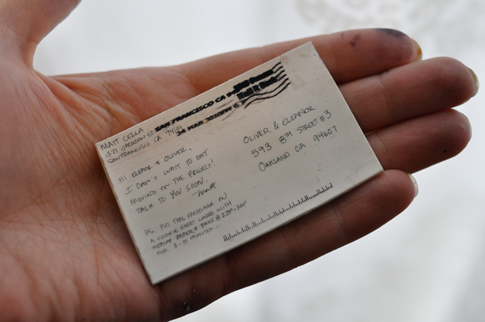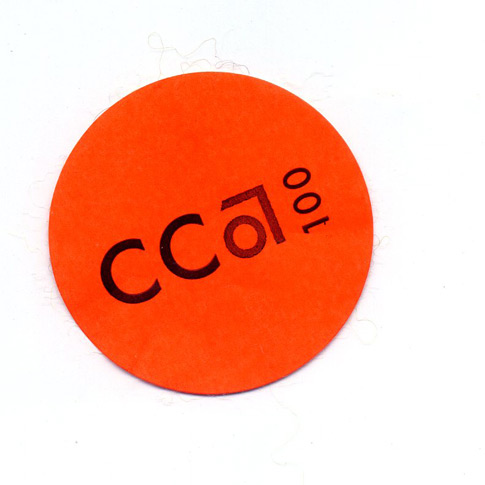2 x 15K for Public Art in the Bay Area: Southern Exposure Offers a New Award
artist resources arts funding bay area blog

For two years, Southern Exposure, enabled by the Graue Family Foundation, is going to offer a 15K award for Public Art Projects in the Bay Area. Artists nationally and internationally are encouraged to apply. It is really wonderful to see some significant awards coming out of the Bay Area.
The Graue Award is an initiative of SoEx Off-Site, a program of Southern Exposure’s founded in 2006 that seeks to commission and present new public work by emerging artists that intervenes and interacts in the social and political spheres beyond the space of gallery. SoEx supports and encourages these practices as few venues support emerging artists working in the public. The artists selected through the program will make a proposal and develop their work in relation the San Francisco Bay Area.
It is an Open Call! Applications for the 2011 project are due May 26th, 2010.
Details Here.
Edible City" class='title'>Edible City
The Bullshit Artists" class='title'>The Bullshit Artists
art world blog contemporary art criticism
Value of Art: Sea Ranch Chapel Edition
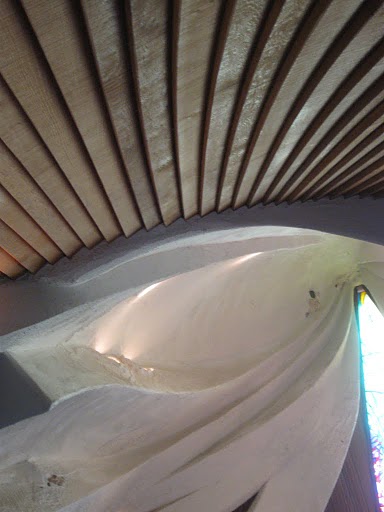
From the Brochure (my italics):
The Sea Ranch Chapel is a gift of two Sea Ranch residents who wished to offer a nondenominational sanctuary for prayer, meditation, and spiritual renewal. It was their hope that all who enter will find a measure of peace in the blending of art and purpose amid surroundings of beauty and inspiration.
The chapel is dedicated to the memory of a young man, navy aviator, artist, and zoologist, who believed that art is the intermediary between the physical and the spiritual.
$200,000 awarded to 26 Califonia Artists: CCI announces it’s Round 5 “Investing in Artists” Grantees.
arts funding bay area blog news
Congratulations to all!
“We know that grants to individual artists are an important means to help them advance their work, and this is particularly true during an economic recession when financial resources are so scarce,” said CCI President and CEO Cora Mirikitani.
Round V of the Center for Cultural Innovation‘s Investing in Artists grants program specifically provided support to working artists in the Visual Arts, Craft and Literary Arts in two categories: 1) for the acquisition of Artistic Equipment & Tools; and 2) for Artistic Innovation.
In the Artistic Equipment & Tools category, fourteen (14) artists received Investing in Artists grants:
· Susan Avila (Craft, Oakland)
· Amy Balkin (Multidisciplinary, San Francisco)
· Chris Bell (Multidisciplinary, San Mateo)
· Cindy Bernard (Visual Arts, Los Angeles)
· James Buckhouse (Multidisciplinary, Palo Alto)
· Heather Bursch (Visual Arts, Los Angeles)
· Joshua Churchill (Multidisciplinary, San Francisco)
· Binh Danh (Photography, San Jose)
· David Gurman (Multidisciplinary, San Francisco)
· Taro Hattori (Visual Arts, Oakland)
· Packard Jennings (Multidisciplinary, Oakland)
· Larry Kline (Visual Arts, Escondido)
· Blaine Merker (Multidisciplinary, San Francisco)
· Kim Stringfellow (Multidisciplinary, Joshua Tree)
In the Artistic Innovation category, twelve (12) artists received Investing in Artists grants:
· Jeff Chang (Literary Arts, Berkeley)
· Sara Daleiden (Multidisciplinary, Los Angeles)
· Sergio de la Torre (Multidisciplinary, San Francisco)
· Amy Franceschini (Visual Arts, San Francisco)
· Guillermo Gomez-Pena (Multidisciplinary, San Francisco)
· Desiree Holman (Multidisciplinary, Oakland)
· Ali Liebegott (Literary Arts, San Francisco)
· Kelly Nipper (Multidisciplinary, Los Angeles)
· Scott Oliver (Visual Arts, Oakland)
· Alison Pebworth (Visual Arts, San Francisco)
· Jessica Rath (Visual Arts, Los Angeles)
· Philip Ross (Multidisciplinary, San Francisco)
The Center For Missed Connections: Charting Loneliness and Social Irrealities
blog CMC contemporary art criticism TPG13
If you live in a city, or even if you don’t, you have likely heard of and/or utilized Craigslist. From its humble beginnings, the website has grown to international proportions; used to place ads for jobs, housing, and those looking for human contact. Perhaps the most compelling aspect of the site is its category Missed Connections (MCs). Here, people post anything from one line to many paragraphs; seeking out those whose path they’ve crossed, people they’ve lost contact with, strangers they’ve seen in bars or cafes or streets that caught their attention. These posts reflect a desire to try and make real contact, when so much of our lives are spent surrounded by strangers, hours at work, or online. In the past year alone, these anonymous listings have inspired a book deal, blogs dedicated to the best of MCs, and artists’ work. Baltimore-based artist Ingrid Burrington has created a piece utilizing Missed Connections that is at once tongue-in-cheek and an adept response to the culture in which we live.
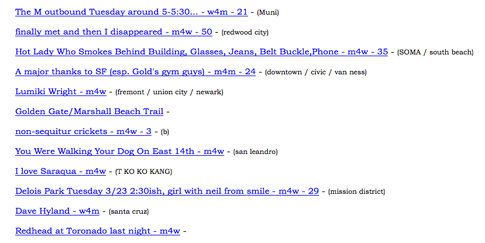
Using her “think tank initiative,” the Center For Missed Connections (CMC), Burrington examines MCs in five cities, charts their trends, and offers a work- booklet so that we might keep a log of our own missed connections as we go about our daily routine. Were someone to stumble upon her findings, one might imagine these graphs and worksheets to be yet another new dating device aimed at an increasingly lonely urban population. Rather, Burrington has created an untraditional piece of work that experiments with and questions our understanding of illusion and reality, blurring the two, while also offering an honest commentary on this phenomenon of communal loneliness and need for human connection in our country. This “outreach initiative” provides a critique of the way in which we communicate, date, relate, and experience loneliness and one another:
“You are in the world, in a city, somewhere crowded and vibrant, full of people. And you are alert with an awareness tempered by the wonderful, unspeakable loneliness of being among strangers… Missed Connections are the embodiment of one of the major lures of cities and urban centers: they are a temporary engagement with a total stranger in uncertain, finite intimacy.”
Burrington takes a humorous look at what constitutes a missed connection, its various forms, and how one may make their post most successful. Various categories of what she deems the “gray area” include, “holla,” “bitches ain’t shit,” and “why doesn’t anyone want to date me.” It’s this superficial cheekiness that cushions the subtext of her work. Rather than beat her audience over the head with the kind of heavy-handedness one might find in some artists’ whose work deals with social commentary; Burrington’s take is comical, relatable, and an astute critique of the way in which our culture often chooses to interact with one another.
Many of Burrington’s projects take things that are mundane- date books, puzzles, and rulers to name a few- and recontextualize them; endowing everyday objects with cultural substance and social critique. Her work is often collaborative, and text appears in nearly every piece. Some take the form of pamphlets and index cards, while others are protest signs or banners that demand “milk & cookies!” or “revolution can be avoided.”
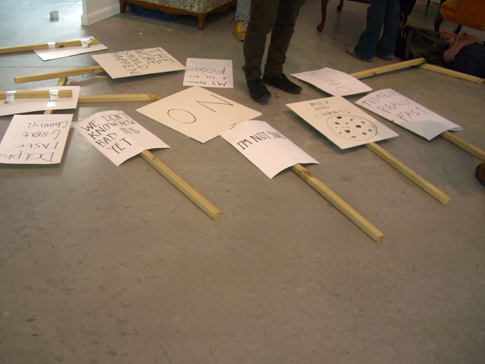 what do we want? NOW! when do we want it? NOW! . Ingrid Burrington and Matt Bettine 2008.
what do we want? NOW! when do we want it? NOW! . Ingrid Burrington and Matt Bettine 2008.
Her work offers a means of resistance to traditional artistic genres, as well as to our current culture and what is valued. In “Tips for experiencing a missed connection,” Burrington advises her reader how to go about becoming an MC. Among them, the artist suggests you: be attractive; identify which an adjective (cute, hot, sexy, etc) that best suits you and try to embody it; leave before any actual contact can be made; and start living. How very apropos that in trying to really live, we abandon actual interaction and possibility in favor of an online fantasy. It is here, and in other pieces, that Burrington subtly dismantles socially constituted norms and brings them into question.
Burrington manages to avoid heavy handedness as she maps the world of MCs. Rather than create a piece that mocks those who flock to Missed Connections in lieu of real human contact, the artist offers us a thoughtful, rather blithe take on the palpable loneliness that seems to proliferate so many of these posts. Between Match.com, OkCupid, eHarmony, and myriad other dating sites, it’s no surprise that we (the collective we) have become disconnected.
If such sites weren’t to exist, would we still feel the same lack of connectedness? It seems that in attempting to quell the feeling of loneliness and isolation, dating sites may compound the feeling; allowing people to search for others at their leisure and in the comfort of their home. Rather than step out into the world where rejection is a real possibility, those who date online only have to face a virtual one, and can quickly move on to the next profile. CMC is a critical look at this delusional approach to interaction, and acknowledges the irony in our attempts to establish contact via Missed Connections with those we wish to engage in reality, but actively choose not to.
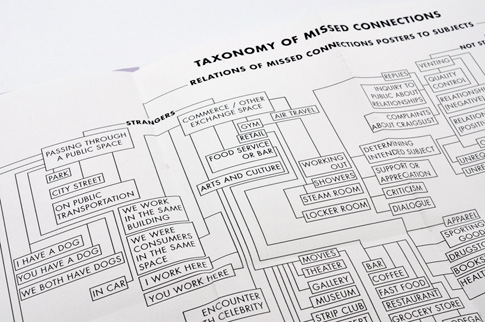 Taxonomy of Missed Connections, detail. In the Center for Missed Connections Citizen’s Field Guide, Center for Missed Connections Information Initiative, 2010
Taxonomy of Missed Connections, detail. In the Center for Missed Connections Citizen’s Field Guide, Center for Missed Connections Information Initiative, 2010
In CMC, we are given statistics, pie charts, and insights into the workings of each city’s MCs. It’s in this urban sea of strangers that we make a connection, and perhaps we find comfort in this collected loneliness. In CMC and other pieces, the artist dares the viewer to ignore this current state of detachment in which we seem to exist. As Burrington navigates the world of interreality through various non-traditional formats, she manages to create works of art that are simultaneously provocative, critical, and humorous; and through them we are given a glimpse at how our culture has dissociated, as well as our genuine desire to find a connection amidst this often self-imposed isolation.
.
.
.
Madeleine Zinn is a writer and erstwhile artist based in Oakland. Her main interests include non-fiction, community arts, pop culture, and queer theory and identity politics. She is currently pursuing a dual MFA/MA in Writing and Visual & Critical Studies at California College of the Arts.
Interview with Ingrid Burrington
Artist Interviews blog CMC TPG13
We interviewed Ingrid Burrington on February 21, 2010.
Introduction to the CMC Information Initiative
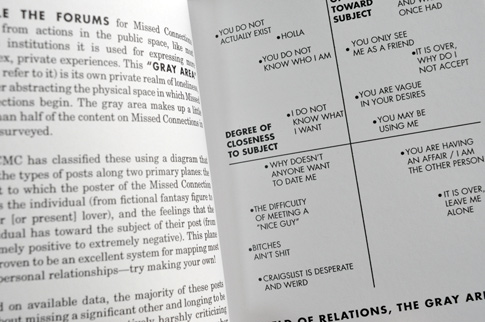
The Center for Missed Connections Information Initiative is an edition of 100 booklet sets by artist Ingrid Burrington analyzing missed connections posts on craigslist.org. It is the most recent project by Burrington’s pseudo-think tank – the CMC – which seeks not only to chart the loneliness of city life but to “encourage people to pay greater attention to those fleeting moments in cities that appear insignificant but linger in memory, producing a richer and more romantic and/or sleazy experience of the urban environment.” The set contains a Citizen’s Field Guide, a Field Observation Workbook, a fold-out “Taxonomy of Missed Connections,” as well as a full-color “Geographic Missed Connections Study: New York”.
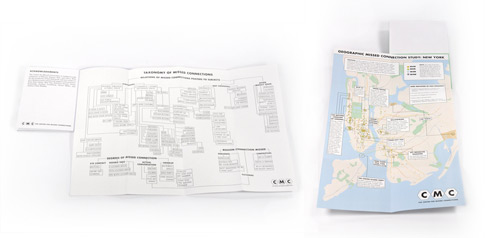
The Citizen’s Field Guide attempts to classify Missed Connections posts on a multitude of criterion such as demographic, degree (double take, actual conversation, hookup), reason for connection missed (in a hurry, not wanting to be “that guy”) and location (gym). The fold-out Taxonomy of Missed Connections visualizes much of this research in an easy to digest format. The field guide also presents the results from a short term comparative study of Missed Connection posts from the same 24 hour period in New York, Chicago, Austin, Boston, and San Francisco.
The Field Observation Workbook encourages you to “Be Out and About!” and experience your own missed connections. Put to work as part of the CMC data collectors, participants are afforded a means to take down details about particular missed connections and have a perfect record should they decide to try to engage that special person online.
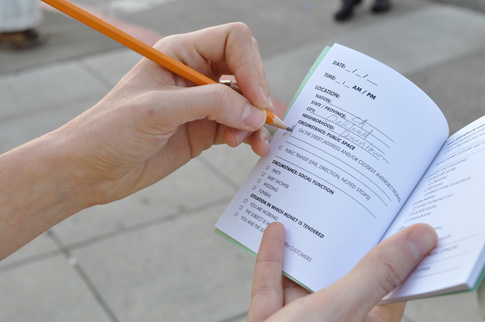
Ingrid Burrington grew up in Northern California and currently lives in Baltimore, Maryland. She works in text, photography, performance, and print, and has produced projects both as a free agent and under the guise of semi-fictional think tanks, which have appeared throughout the mid-Atlantic and online. She received her BFA from the Maryland Institute College of Art in printmaking.
TPG Expands: Web hosting that Support Artists
artist resources arts funding bay area blog good things internet news
We are on a mission to find more ways to get money into artists hands. Following the funding models that seem to work, models that seem to use what people are paying for anyway, we have decided to start hosing websites. A website has almost become a business card these days. So we wanted to create a platform that would not only help people create their own websites in an affordable way, but give them the opportunity to do something good with the money they would be spending anyway to host their sites.
So host with us! At $84/year, it is comparable to most quality hosting sites out there. Over a quarter of that payment goes directly into The Present Group granting fund. Each granting period, we will choose a theme, accept nominations from within that theme, and allow all the hostees to vote on the winner.
For the first grant, we are teaming up with the Collective Foundation to fund a travel grant for a Bay Area artist. As Renny Pritikin has noted on the SFMOMA blog, the Bay Area sometimes has a hard time holding on to its notable artists. Inspired by the way many other governments work, Joseph del Pesco‘s idea is that part of keeping artists here is to help them with the funds to travel away for opportunities and come back.
Up Next: Matthew Cella
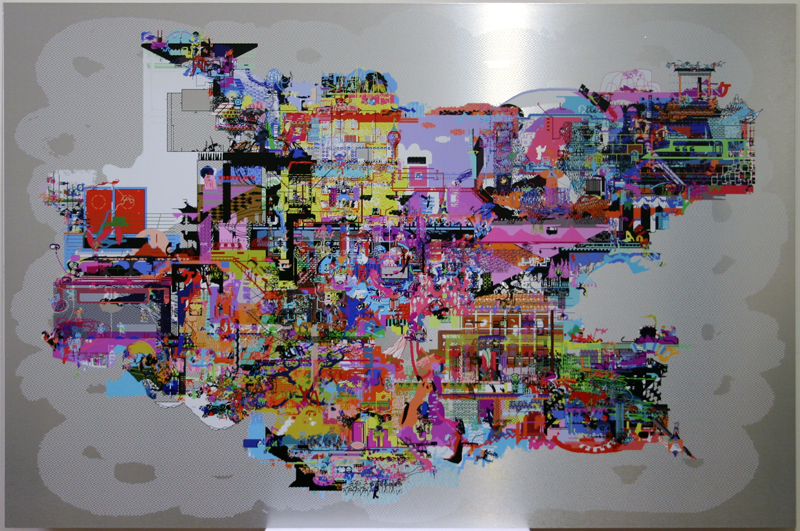 Matthew Cella, “Map 1024,” 48″ x 72″ UV print on brushed aluminum
Matthew Cella, “Map 1024,” 48″ x 72″ UV print on brushed aluminum
Matt Cella fabricates multi-media works that are the product of digitally collaged .;::’til;ps and //??>s. Born in 1981, he received his MFA from the San Francisco Art Institute, and currently lives and works in San Francisco.
I guess I’ve always liked Social Practice..
I was warming my bum at our heater and I found myself staring at our bookshelf’s row of artist books. Nestled in between was one of the first books I’ve ever made: The Painter. I think I was in 4th or 5th grade.
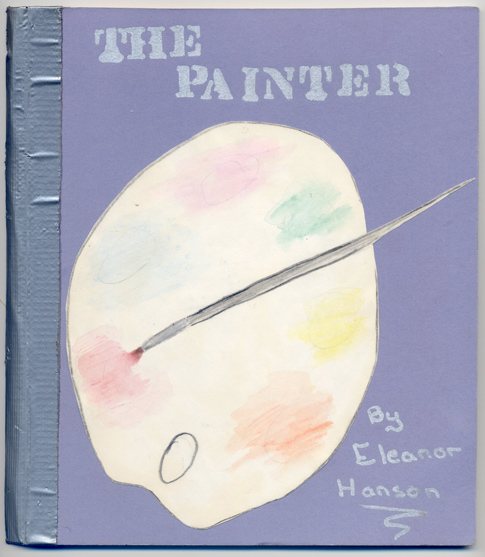
Here’s the story, spelling intact:
Once apon a time there was a little village inside a forest. Inside the village everyone was always sad and dreary.
One day a painter came into the village to paint. When he started to paint the people, he realized that they always had frowns on their faces.
The painter wanted to know why, so he would pick a dfferent spot each day, sit there, and watch the people.
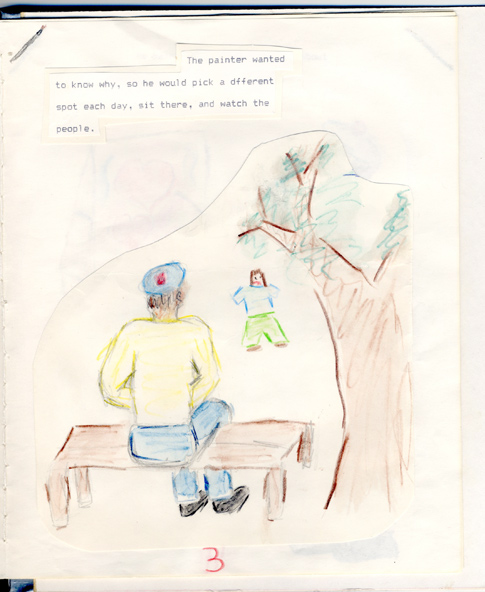
Pretty soon he saw that there were no families, romances or friends. The painter wanted to end this, so he got to work.
He painted beautiful pictures about love and some about friendship.
Then the next week he picked a day and gave away all the paintings on one condition. The condition was that all the villagers had to give their paintings to someone else on the day after next.
He ran out of paintings that day, but that night he made some paintings. Before the day that every one had to give their paintings, the painter made sure everyone in the village had a painting.
On the day that everyone gave their paintings to someone else, everyone was happy. From then on they did this every year, except only with cards, and this was the begining of Valentine’s Day.
The End.
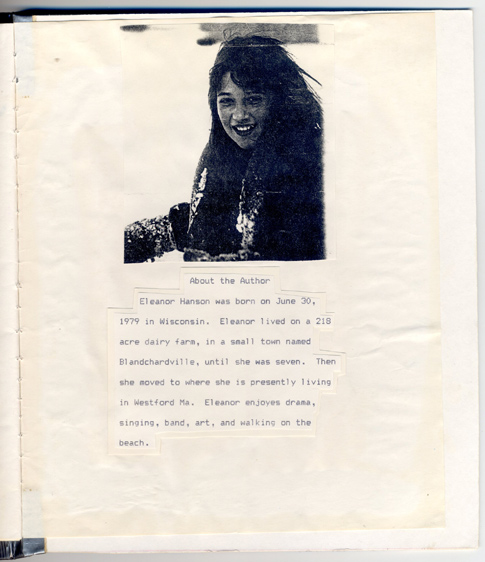
The Value of Art: Bernard Berenson
J. Carter Brown talking about his mentor Bernard Berenson:
According to Brown, the elder art historian “found, at the end of his life, that his great experiences came in his daily walk, which he did at the end of the day up behind I Tatti, where, he said, the fruits of a lifetime of looking at art objects allowed him to look at nature in a newly meaningful way.”
found in “Reciprocal Generosity” by Mary Jane Jacob in
What we want is free, generosity and exchange in recent art
edited by Ted Purves
Alula Editions: A new art subscription & An open call
art and craft arts funding bay area blog collecting resources neat projects opportunities subscription art TPG artists TPG11
TPG #11 artist Helena Keeffe has teamed up with Amber Cady to start Alula Editions, a new art subscription whose focus is to work with artists to create repeat patterns for textiles. They collaborate with individual artists and also organize participatory group drawing activities in order to create textiles that defy expectations and move beyond purely aesthetic considerations.
They have an Open Call for Submissions with a deadline of April 28th, and artists receive a $500 stipend.
Starting off with a bang, Alula Editions was a recipient of this year’s Southern Exposure Alternative Exposure Grant, will be collaborating with artists in Portland, Oregon to create the official tote bag for the Open Engagement Conference at Portland State University, and will be printing their first edition as part of a residency at the Headlands Center for the Arts.
They haven’t figured out their pricing structure yet, so subscriptions are not yet on sale. But you can get on a mailing list so you will be the first to know when they are. The first work is projected to go out this summer.
Welcome Alula!
Longevity
Sometimes it seems trite to say that you just have to keep working, even if what you’re making isn’t so great. But part of the creative process, and those that ultimately “succeed” in creative fields are those who have the faith and perseverance to make it through the time when the only thing that seems to make sense is to give up.
Ira Glass gives us the faith and courage to keep going.
Fear of Engagement
blog good things neat projects
Last night we went to a screening and discussion of the film “Examined Life” as part of our Pickpocket Alamanack class. The film is a philosophy discussion with thinkers across the country in an engaging and easy on the eyes format.
In the followup discussion, Astra Taylor, the director/filmaker, talked a bit about how much fear people had towards the idea of a movie about philosophy, how even her well educated friends would recoil at the idea, considering themselves much too uneducated to even approach or engage the subject matter.
I feel like I have been saying the same thing for years about art. Where does this fear come from? Why is our society so fearful of expressing their thoughts about a subject? And why does so often this fear prevent us from experiencing or engaging at all?
The YBCA has started a free series to address it. Looks fun.
In class: CCA
Yesterday Oliver and I spoke at CCA for a little bit about The Present Group. The class is a really neat investigation of different systems of exchange co-taught by TPG#5 critic Scott Oliver and Rachel Robinette.
One of the underlying questions was whether our project, as commendable as it may be, is sustainable. Can the desire to learn about art be a powerful enough tool in marketing? Can people wrap their heads around collecting artwork for the sake of learning about it rather than it be an investment, or a chosen work to keep in your home?
We’re still not sure. We are still a small project, and we haven’t had as much success financially as some of our competitors. But we believe that the system already exists for people to support artists whose work they know and like and collect their artwork in particular. We know that we are asking a lot of people when we ask them to think that what they are supporting is the creation of art in general, not just the result that they receive.
The funny thing to me is that it doesn’t seem foreign. Museum memberships and Season Pass holders to theatres work under this same assumption, and for a similar price point. The main difference is that they aren’t filling up their home with anything. Perhaps what we need to focus on is a way for people to support us without having to keep the pieces once they’ve learned about them.
Just some musings…
LINKS
Archives
Lego Hello World
I wish all my printers were made of legos.
LIFE photo archive hosted by Google
Images from Life Magazine going back to 1860′s, hosted by Google
Coming Face To Face With The President
Well crafted story about an under-heard point of view.
In California, Pot Is Now an Art Patron
A new funding source for the arts – reaping big rewards and funding many projects. It’s pot.
Notes on Portraiture in the Facebook Age
Celebrity Book Club: A List to End All Lists
Because, well, it’s sortof awesome.
Are "Artists' Statements" Really Necessary?
The pros and cons about that nemesis for most artists.
This to That
You tell it what you’ve got and it’ll tell you what to glue them together with.
Work of art: Online store for buyers, sellers
Not the TV show! Kelly Lynn Jones from Little Paper Planes is interviewed on her project, gives us a cheat sheet to local affordable art resources.

